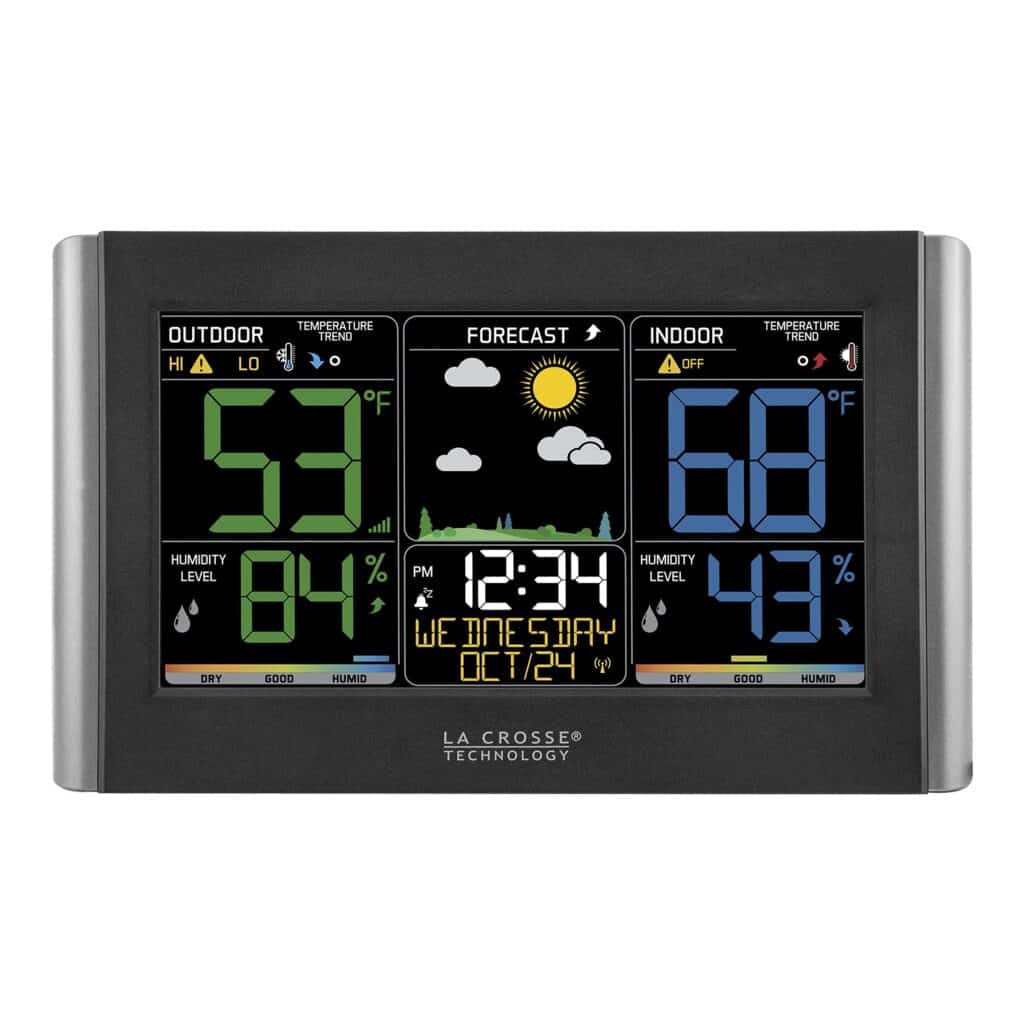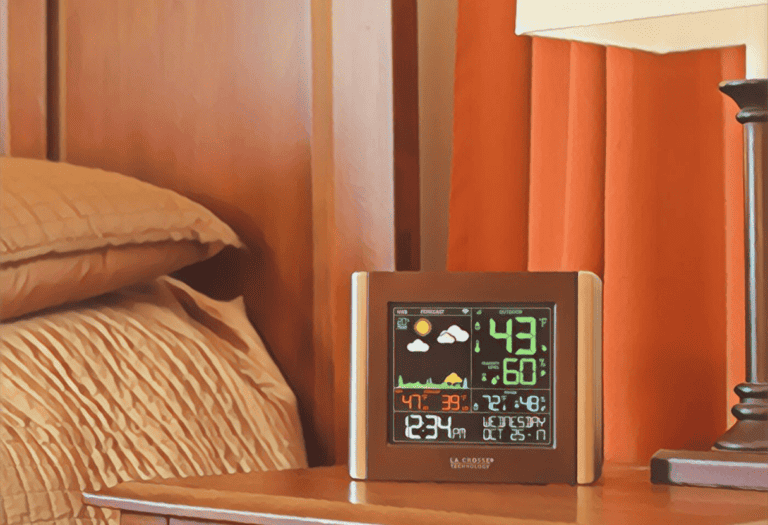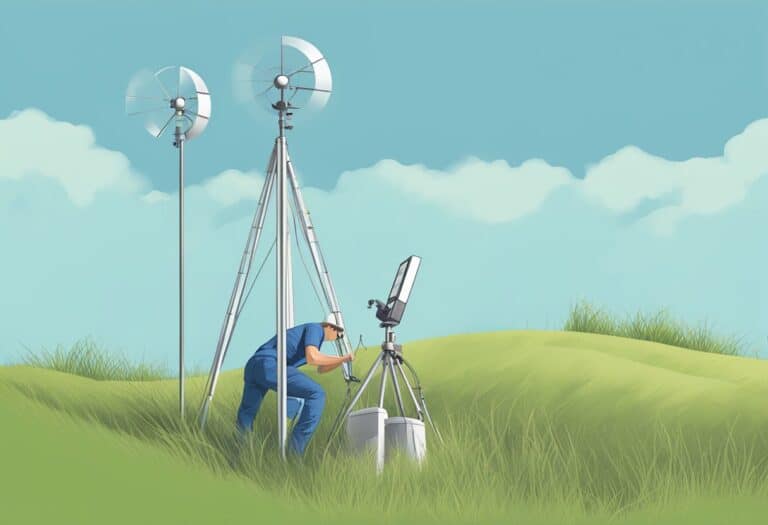Ever wondered what makes the best home weather station tick?
Keeping track of the weather is not just a hobby for some; it’s a crucial part of daily life, especially for those in weather-sensitive jobs. Home weather stations have evolved into sophisticated gadgets, offering real-time, detailed climate information.
But with so many on the market, how do you choose the right one?
Well, we’ll be going over:
- What are the essential features to look for in a top-notch home weather station?
- How do different home weather stations compare in terms of accuracy and ease of use?
- What makes some weather stations stand out in terms of value for money and overall functionality?
Whether you’re a weather enthusiast or need precise climate data for practical reasons, finding the right home weather station is key.
Let’s dive in.
Top Picks for Home Weather Stations
- Ambient Weather Station – Top Pick
- La Crosse Weather Companion
- Sainlogic Wireless Station
- Sainlogic WiFi Station
- Sainlogic Weather Pro
I’ve researched and analyzed the leading home weather stations on the market, carefully considering their features, reliability, and user feedback. In my quest to ensure accuracy and comprehensive weather data for personal use, I present to you a curated list of the best options available. Whether you’re a weather enthusiast or simply like to be prepared for any atmospheric changes, these stations will meet your needs.
Ambient Weather Station

I’m impressed with the Ambient Weather Station’s comprehensive data and connectivity, making it a top pick for monitoring weather conditions.
Pros
Cons
The Ambient Weather WS-2902 is a deserving mainstay in my home. Its vibrant LCD display presents all the essential weather stats with clarity and style. The integrated sensor suite is a powerhouse, measuring everything from wind speed and direction to UV and solar radiation. This is a real treat for someone as data-hungry as I am, always eager to know exactly what’s going on outside my window.
Right off the bat, I noticed the Ambient Weather Station blends into my home seamlessly, thanks to its sleek design. Setting it up was no hassle; within minutes, I was getting accurate readings. The absence of a pole mount and batteries out of the box was slightly inconvenient, but I quickly found compatible ones, and I was ready to roll.
The station’s Wi-Fi capability is fantastic. Once connected, I joined the weather enthusiast community, sharing and comparing data. A minor gripe is the occasional Wi-Fi drop which I noticed during the nights, although this did not diminish my overall experience.
I appreciate that this device supports both imperial and metric units, making it versatile for a user like me who switches between the two. Calibration is a necessary step to ensure precision, and while it might take extra effort upfront, it’s well worth it for the accuracy provided.
In all, the Ambient Weather Station offers a fantastic balance of extensive features and user-friendliness. Despite the minor hurdles of setup and occasional connectivity hiccups, it has proven to be a reliable and informative companion for my daily weather checks.
La Crosse Weather Companion

If you’re in the market for an accurate and vivid display of both time and weather conditions, you may find this station to be a delightful addition to your home.
Pros
Cons
After setting up the La Crosse Weather Station in my living room, I immediately noticed the striking, full-color display. It has a warm presence, consistently keeping me informed of both indoor and outdoor conditions. The self-setting atomic clock is a fine touch, ensuring I’m never a second out of sync with the world outside my window.
Another handy feature I appreciated was the customized alerts. Not only am I notified of extreme temperature dips and spikes, but I can also track the humidity levels. This dual focus on temperature and humidity empowers me to plan my day with greater confidence, whether I’m picking out clothes or deciding about that long-awaited hiking trip.
Tweaking the settings to my preference was a breeze, and the color-coded comfort level bar really helped me understand the subtleties of my home’s microclimate. Although the device’s brightness could be better—making it occasionally tough to read from certain angles—I’ve found a sweet spot on my shelf where the screen is clear and vibrant.
In summary, while this La Crosse model demands minor adjustments and attention to placement, it compensates with its engaging display and precise weather tracking capabilities. For anyone passionate about staying ahead of the weather right from the coziness of their abode, this weather station hits the mark.
Sainlogic Wireless Station

After spending some time with the Sainlogic Weather Station, I consider it a reliable choice for anyone serious about tracking local weather patterns directly from their home.
Pros
Cons
I recently installed the Sainlogic WiFi Weather Station at my home, and it’s been tracking the local climate with precision. The colorful, large display is a pleasure to look at and makes it simple to monitor data from various vantage points within my living space. The weather forecasts that it provides have been accurate, allowing me to plan my outdoor activities with confidence.
My interaction with the device showed that the Wi-Fi capabilities of this weather station enable easy data transfer and analysis through popular platforms like Weather Underground. I found it quite satisfying to view comprehensive weather data on those platforms that went beyond the basic details.
The device’s design, combining a rain gauge and wind speed meter, gives me a comprehensive understanding of the weather conditions around me. However, I must note that setting up the outdoor sensor was a bit time-consuming, and making sure it was properly positioned to receive sunlight for the solar panel required some thought. While the dependence on solar power is eco-friendly, it does mean that the device may be less effective on cloudy or rainy days.
In conclusion, the Sainlogic WiFi Weather Station is a solid companion for both weather enthusiasts and homeowners looking to stay informed about their local meteorological conditions.
Sainlogic WiFi Station

After exploring the Sainlogic Weather Station’s features, I believe it’s a solid choice for anyone interested in tracking local weather with high precision.
Pros
Cons
Upon unboxing, I was immediately taken by the large, colorful display of the Sainlogic Professional WiFi Weather Station. The LCD screen beams with information and remains legible from different vantage points. This was especially helpful when I glanced at it from across the yard—no squinting necessary.
The weather station interfaced smoothly with both Weather Underground and Weathercloud. This easy connection to global weather networks provided me a sense of community, knowing my data contributed to the larger pool of information available to weather enthusiasts. Sharing has never felt easier.
The 10-in-1 outdoor sensor is the workhorse, providing exhaustive data covering temperature, humidity, wind speed, and direction, to name a few. I found the assembly straightforward using the provided instructions. Mounting it was a light afternoon project, and I enjoyed how quickly it began to transmit information.
My only nitpicks stem from the absence of batteries, which meant a separate purchase was necessary to get started. Additionally, while I am quite tech-savvy, some may find the initial setup and syncing with external apps a tad involved. The weather predictions also were not always spot-on, but keeping in mind that meteorology isn’t an exact science, it was acceptably accurate.
Overall, the Sainlogic Professional WiFi Weather Station delighted me with its rich features and reliable performance. Despite minor hiccups, I’ve found its readouts to be a dependable snapshot of my local weather, making it a worthy addition to my home tools.
Sainlogic Weather Pro

I found the Sainlogic Weather Station to be an insightful tool for any home, providing detailed weather updates with its large display and comprehensive features.
Pros
Cons
After setting up the Sainlogic WiFi Weather Station in my backyard, I immediately noticed the large display’s clarity from across my patio, which presented a plethora of weather details. Monitoring wind speed, temperature, and rainfall became a daily routine, almost a new morning ritual to prepare for the day ahead.
In my home office, the device connected seamlessly to my Wi-Fi, allowing me to keep tabs on the weather through the Sainlogic app and contribute my data to Weather Underground. This integration not only gave me a sense of contribution to the wider community but also a deeper look into weather patterns over time.
Lastly, while I appreciated the station running on solar power, I noted that it required the purchase of batteries to get started. And at night, the vibrant display was a tad too luminous for my taste, but certainly not a deal-breaker considering the wealth of information at my fingertips.
Buying Guide
Key Features to Consider
When selecting a home weather station, I consider several crucial features to find the best fit for my needs. Accuracy is paramount; I look for stations that boast high-precision sensors to ensure the data I rely on is dependable. Connectivity is another key aspect; wireless models with strong signal range keep data flowing uninterruptedly to my devices.
User-Friendly Interface
A user-friendly display is non-negotiable for me. I prefer a clear, easy-to-read interface that makes it simple to grasp the data at a glance. Customizable alerts for specific weather conditions are highly beneficial, helping me stay informed of changes that matter most.
Durability and Sensor Range
- Durability: The weather station should withstand local weather extremes; I seek robust construction with high-quality materials.
- Sensor Range: The number of sensors and the breadth of data they capture is important. I like to have temperature, humidity, rainfall, wind speed, and direction information readily available.
Installation and Maintenance
Ease of installation is a practical factor — I prefer weather stations that are straightforward to set up. Also, maintenance requirements should be minimal; a weather station with self-cleaning sensors appeals to me for ease of upkeep.
Data Recording and History
Monitoring trends is vital for me, so I look for a model with data logging capabilities. The ability to review historical data helps me understand weather patterns over time.
Budget Considerations
Lastly, price plays a role; models range widely in cost. I balance the features I need with my budget, ensuring that I get a reliable unit without excessive spending. Finding the sweet spot between cost and functionality is crucial in making a satisfactory purchase.
Frequently Asked Questions
In this section, I’m going to address some common inquiries regarding home weather stations, focusing on features, differences for specific uses, cost-effective options, trusted brands, and the benefits of NOAA compatibility.
What features should I look for in a high-quality home weather station?
A high-quality home weather station should offer accurate readings of temperature, humidity, wind speed, and direction. It should also have a rain gauge for precipitation tracking and the ability to provide barometric pressure data. Connectivity for data analysis, like smartphone or computer syncing, is also crucial.
How do weather stations for farmers differ from standard home weather stations?
Weather stations designed for farmers typically include features like soil temperature and moisture sensors, specific data for crop management, and more robust construction to withstand agricultural environments. They may also offer detailed historical data logging to help predict future conditions and plan farming activities.
What are the best weather stations available for under $100?
At under $100, reliable weather stations like the ThermoPro TP67A and the La Crosse Technology C85845 provide accurate temperature, humidity, and barometric pressure readings. They might lack some advanced features but are dependable for basic weather monitoring needs.
Which weather station brands are recommended for accuracy and reliability?
For accuracy and reliability, brands like Davis Instruments and Ambient Weather are highly recommended. Davis Instruments’ weather stations, especially the Vantage Vue and Vantage Pro2, are recognized for professional-grade precision. Ambient Weather also offers robust functionality with stations like the WS-2902C.
How do AcuRite weather stations compare to La Crosse in terms of performance?
AcuRite weather stations generally offer comprehensive data and a user-friendly interface, making them suitable for those seeking an easy-to-navigate system. La Crosse weather stations are known for their seamless integration with smart home systems and provide reliable weather monitoring. Both brands are respected for their performance in home settings.
What are the benefits of having a NOAA compatible weather station at home?
A NOAA compatible weather station ensures access to official weather alerts and forecasts, which can be vital for emergency preparedness. It allows for a seamless integration of local weather conditions with national weather service data, giving me accurate and up-to-date weather information.







